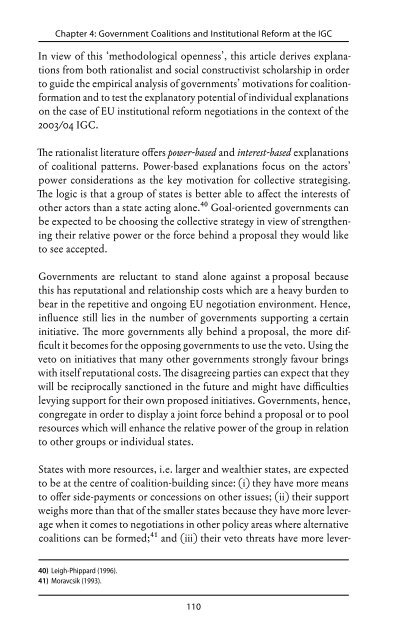eu constitutionalisation - EUROPEUM Institute for European Policy
eu constitutionalisation - EUROPEUM Institute for European Policy
eu constitutionalisation - EUROPEUM Institute for European Policy
Create successful ePaper yourself
Turn your PDF publications into a flip-book with our unique Google optimized e-Paper software.
Chapter 4: Government Coalitions and Institutional Re<strong>for</strong>m at the IGCIn view of this ‘methodological openness’, this article derives explanationsfrom both rationalist and social constructivist scholarship in orderto guide the empirical analysis of governments’ motivations <strong>for</strong> coalition<strong>for</strong>mationand to test the explanatory potential of individual explanationson the case of EU institutional re<strong>for</strong>m negotiations in the context of the2003/04 IGC.The rationalist literature offers power-based and interest-based explanationsof coalitional patterns. Power-based explanations focus on the actors’power considerations as the key motivation <strong>for</strong> collective strategising.The logic is that a group of states is better able to affect the interests ofother actors than a state acting alone.⁴⁰ Goal-oriented governments canbe expected to be choosing the collective strategy in view of strengtheningtheir relative power or the <strong>for</strong>ce behind a proposal they would liketo see accepted.Governments are reluctant to stand alone against a proposal becausethis has reputational and relationship costs which are a heavy burden tobear in the repetitive and ongoing EU negotiation environment. Hence,influence still lies in the number of governments supporting a certaininitiative. The more governments ally behind a proposal, the more difficultit becomes <strong>for</strong> the opposing governments to use the veto. Using theveto on initiatives that many other governments strongly favour bringswith itself reputational costs. The disagreeing parties can expect that theywill be reciprocally sanctioned in the future and might have difficultieslevying support <strong>for</strong> their own proposed initiatives. Governments, hence,congregate in order to display a joint <strong>for</strong>ce behind a proposal or to poolresources which will enhance the relative power of the group in relationto other groups or individual states.States with more resources, i.e. larger and wealthier states, are expectedto be at the centre of coalition-building since: (i) they have more meansto offer side-payments or concessions on other issues; (ii) their supportweighs more than that of the smaller states because they have more leveragewhen it comes to negotiations in other policy areas where alternativecoalitions can be <strong>for</strong>med;⁴¹ and (iii) their veto threats have more lever-40) Leigh-Phippard (1996).41) Moravcsik (1993).110Chapter 4: Government Coalitions and Institutional Re<strong>for</strong>m at the IGCage (again because smaller states fear reciprocal blocking actions of theirproposals in other policy-areas). The key to understanding the power oflarge states in institutional re<strong>for</strong>m negotiations is in recognising that EUnegotiations are interlinked and continuous. The choices of a governmentin one negotiation situation matter <strong>for</strong> other negotiation situations.The ‘policy-based’ or ‘interest-based’ explanation of coalition-<strong>for</strong>mationposits that coalitions are <strong>for</strong>med when there is congruence in the actors’interests.⁴² <strong>Policy</strong> distance between individual actors is, hence, the keydeterminant of coalitions. The primary goal is to get the specific sharedinterest realised, which means there is no immediate expectation ofcooperation on other issues. Interest-based coalitions are predicted tobe issue-specific and short-term.⁴³ The more congruent the members’interests, the more <strong>for</strong>mal and active becomes the coalition.⁴⁴ To establishthe prevalence of interest-based coalitions in the case study, I will seekto identify those coalitions that cooperate on a single issue or very fewissues among the institutional provisions and do not display any <strong>for</strong>malityof the arrangement.The social constructivist account offers two further explanations ofcoalition patterns: ideology-based and culture-based coalitional patterns.Ideology-based explanations posit that coalition-<strong>for</strong>mation among governmentsis driven by ideology (i.e. policy distance, similarity in worldviews and values to which the governments subscribe). Different aspectsof a government’s ideology will be pertinent to different policy areas. Oninstitutional issues, the pro-integrationists or intergovernmentalist viewsand the large-small state dichotomy prevail.⁴⁵ On economic and socialpolicies, the left-right divide is relevant as it captures governments’ (andtheir publics’) positions on two sets of issues: intervention-free marketissues, such as welfare policies, unemployment and inflation; and liberty-authorityissues, such as environmentalism and minority rights.⁴⁶ Inprinciple then, governments that share party political affiliations (belongto the same <strong>European</strong> party family) should be more likely to <strong>for</strong>m coalitionsgiven the similarities in their views.42) Bilal and Hosli (1999); Elgström et al (2001); Kaeding and Selck (2005).43) Elgström et al (2001): 120; Kaeding and Selck (2005): 274.44) DuPont (1994).45) Magnette and Nicolaidis (2003); Tsebelis and Garrett (2000).46) Hix, Noury and Roland (2005): 218; Hooghe, Marks and Wilson (2002).111








